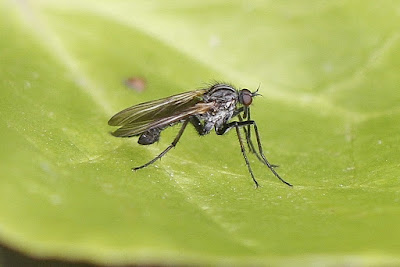Earlier , in better conditions , a look up on the Common produced a few bits of interest ,
a Tick-Ixodida , probably brought in by one of the Roe Deer , deer being a major carrier of the ticks , which in turn can be carriers of Lyme disease , which can be transmitted to humans if they latch on to the body .
The first male Common Heath moths have emerged and as usual , difficult to photograph .
Amongst the grass , the delicate Dovesfoot Cranesbill-Geranium molle ,
and it looks like there will be a good supply of berries on theflowering Rowan-Sorbus aucaparia .
females , was lucky enough to see the first pairing and since then , a second pairing has been observed .
The Brimstones that over-wintered as adult , are gradually reducing in numbers as their time is finished , their offspring will appear later in the Summer .
I've found it another disappointing Spring for Orange Tips , and searching for eggs hasn't given much hope for next year , so few being found .
An unusual fly with an orange abdomen , seems to tick the boxes for Rhingia rostrata .
A quick look at Keston Ponds whilst en route to High Elms , found this female Mandarin with her six ducklings , which look very good look alikes for Mallard ducklings at this stage .
The butterfly transects at High Elms are still a struggle to find anything on some sections . Species numbers are up to 11 at best , but total numbers are still way down , once again I put it down to the fact that much of the grassland was cut far too early last Autumn , destroying many butterfly eggs and larvae in the process .
Common Blue , a typical grassland species have emerged , but only on Burnt Gorse , where the gang mower cannot gt to , thank goodness .
It is also where the few Green Hairstreaks have been recorded , the females now laying the eggs that will be the next generation . After this one moved on , it took some time to find the small pearly green egg , nestled
in the buds of one of their foodplants , Birdsfoot Trefoil .
Also found was the first Garden Chafer-Phyllopertha horticola . No doubt the first of many , as they can be present in very large numbers some years .
The first Birdsnest Ochids have emerged , just four at the moment , but I get the feeling that orchids in
general look as if they are not having a good year so far either . The first White Helleborine also found , and
also the first Common Spotted Orchid to burst bud . Along the paths , evidence of Wych Elm , with lots of leaves and seeds on the ground . Thee fact that the seed is in the middle of the disc , determines that it is
Wych and not another member of the Elm family .
I've made a couple of visits to a site bellow Biggin Hill Airport where it was rumoured that Small Blues were seen last Summer . I'm glad to say that the rumour was true , having found 2 males on each visit and hoping
for more to emerge . Also on site , Swollen Thigh Beetle-Oedemera nobilis , only the male suffers the
swelling and what seems to be a solitary wasp , Gorytes quadrifasciatus .
A couple of stops at Spring Park Pond produced only common species of damselfly , but on vegetation
around the pond , Malachite Beetle or Red-tipped Flower Beetle-Malachius bipustulatus and a very
long-legged , evil looking fly Empis tessellata were found , both in good numbers . In the small meadow , a
well named Oak-striped Bug-Rhabdomiris striatellus was sunning itself on an Oak leaf and nearby ,
Bishop's Mitre-Aelia acuminata posed too . Between the pond and the meadow , the coppiced Small-leaved
Limes are regenerating really well .
My last visit to Hutchinsons Bank at the weekend , produced an opportunity to photograph the second
abarrant Glanville Fritillay , found earlier in the week , a lighter toned individual than the first . At the top of
the site , the Sainfoin-Onobrychis viciifolia , a member of the Pea family has started flowering , adding colour and more nectar for the invertibrates . On my way home , I stopped at a nearby Wych Elm to look for
White-letter Hairstreak larvae . Just two were found , one the usual green form , but the other was my first
brown form , indicating that it is about to pupate . Strange thing is , I look for these larvae every time I do the HE transect , finding feeding damage on leaves , but never a larva . Also found on the Wych Elm was this
Copper Underwing larva which has cannibalistic tendencies , so WLHs beware .
Back home , we have had Robin , Blackbird and Dunnock fledglings in the garden and after much noise from
the Blue Tit box , all was quiet the other morning apart fro the odd squeak from this little one , on the grass in front of the box . Not a good situation , with several Corvids flying around . so , without much fuss , the
fledgling let me pick it up and place it in the Hawthorn tree . Almost immediately the parents found it and
returned constantly with food . Next time I looked , it was out in the open again and loudly calling for food .It moved several times around the garden and was still calling late evening . I hope it makes it .































































